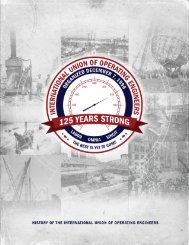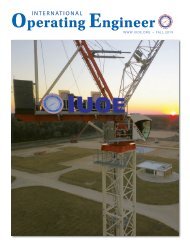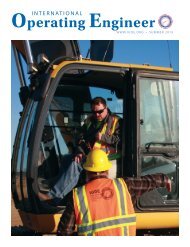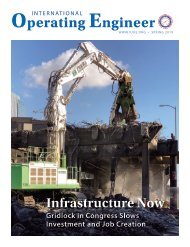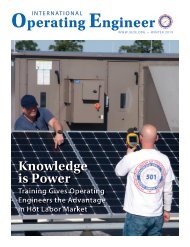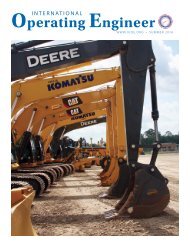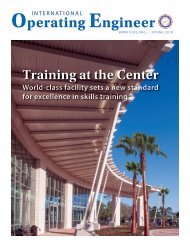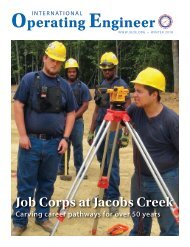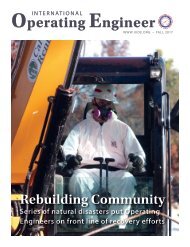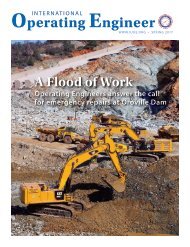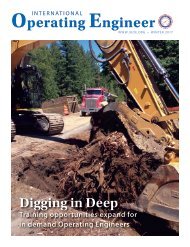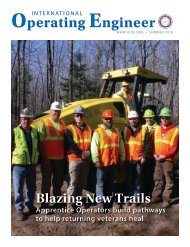Operating Engineer - Fall 2014
The quarterly magazine of the International Union of Operating Engineers.
The quarterly magazine of the International Union of Operating Engineers.
You also want an ePaper? Increase the reach of your titles
YUMPU automatically turns print PDFs into web optimized ePapers that Google loves.
Our Work: Energy<br />
Natural Gas Boom Brings Work Up and Down the Line<br />
OVER THE LAST DECADE, natural<br />
gas production in the United States has<br />
redefined the term “boom times” and<br />
<strong>Operating</strong> <strong>Engineer</strong>s have been among<br />
the beneficiaries, as skilled hands have<br />
been in high demand. During this<br />
period, the center of the natural gas<br />
universe has been the Marcellus shale,<br />
which lies beneath the states of Ohio,<br />
West Virginia, Pennsylvania and New<br />
York.<br />
Marcellus is the largest shale gas<br />
play In North America, accounting<br />
for close to one-fifth of the country’s<br />
total gas production. It is is estimated<br />
to hold about 141 trillion cubic feet<br />
of technically recoverable natural gas<br />
reserves. The play’s proximity to highdemand<br />
markets on the East Coast<br />
makes it attractive to gas producers,<br />
since it enables lower transportation<br />
costs.<br />
Production from the Marcellus has<br />
been soaring, growing from less than<br />
2 billion cubic feet per day (bcf/d) in<br />
2007 to about 16 bcf/d currently, and<br />
production could rise to as much as 20<br />
bcf/d by 2020.<br />
As production has grown, so<br />
have job opportunities for <strong>Operating</strong><br />
<strong>Engineer</strong>s within all phases of the<br />
production stream. Upstream jobs –<br />
site preparation, well pad construction,<br />
drilling and reclamation – have been a<br />
steady source of work for <strong>Operating</strong><br />
<strong>Engineer</strong>s within the Marcellus region.<br />
Midstream and downstream work<br />
– particularly pipeline construction –<br />
have also brought new opportunities to<br />
<strong>Operating</strong> <strong>Engineer</strong> members, helping<br />
to overcome the decline in other<br />
construction sectors caused by the<br />
recent recession.<br />
The expansion of this valuable<br />
domestic resource is now producing a<br />
steady flow of jobs even further down<br />
the production stream. One of these<br />
projects, a new $1.3 billion dollar<br />
power generating plant – fueled by<br />
the abundant, low-cost, clean burning<br />
natural gas coming out of the Marcellus<br />
shale – is putting Local 147 <strong>Operating</strong><br />
<strong>Engineer</strong>s back in the seat after some<br />
pretty lean years.<br />
“It has been many years since<br />
Local 147 had a big job such as this,”<br />
says Business Manager Darold Kemp,<br />
referring to the Brunswick County<br />
Power Station being built by Dominion<br />
Virginia Power in rural southern<br />
Virginia.<br />
The 1,360-megawatt natural gas<br />
power station will serve a growing<br />
customer demand in the state, as<br />
well as replace electricity from two<br />
aging coal-fired power stations that<br />
are being retired for economic and<br />
environmental reasons.<br />
Construction began in September<br />
2013, and the project is currently<br />
on budget and on schedule to be<br />
generating electricity by the summer<br />
of 2016, according to Dominion. The<br />
utility awarded the overall design and<br />
construction contract to Fluor, who<br />
brought in National Steel Erection,<br />
Inc. based out of Kentucky. NSE is the<br />
only subcontractor utilizing skilled<br />
union labor and has fifteen Local 147<br />
<strong>Operating</strong> <strong>Engineer</strong>s working on site.<br />
The combined-cycle power station<br />
will use natural gas to fire three<br />
combustion turbines – essentially<br />
super-sized jet engines – to generate<br />
about 810 megawatts. The heated air<br />
from the combustion turbines will be<br />
captured and used to create steam that<br />
will spin another turbine to produce<br />
about 550 megawatts. To accomplish<br />
this, it will have the largest air-cooled<br />
condenser of its type ever erected in<br />
the United States. The station’s total<br />
output of 1,360 megawatts can provide<br />
electricity for about 340,000 homes.<br />
[above] L to R: (three on front row) Mike Kowalski, Business Agent; Ray Rhode, job Steward<br />
and crane operator; Mike Dock, NSE Superintendent (four on second row) Travis Conner,<br />
crane operator; J.W. Wright, crane operator; Jerry Conner, Business Agent; James Dodd Jr.<br />
apprentice (five on third row) Bobby Falkner, crane operator; Gerald Simpson, Training Director;<br />
Shawn Treadwell, apprentice; Chris Giles, crane operator; Tim Morgan, apprentice<br />
(Eight on back row) Randy Sisco, crane operator; John Dunavant, crane operator; Lee Freeman,<br />
crane operator; Trey Freeman, apprentice; James Dodd, crane operator; Timmy Giles,<br />
forklift operator; Dave Michl, NSE Project Manager; Zachery Freeman, crane operator.<br />
[photo] JDarold S. Kemp, Business Manager, Local 147<br />
An investment on this scale<br />
generates a lot of tax dollars in addition<br />
to jobs. An estimated $824 million in<br />
new economic activity statewide and<br />
a 45 percent increase to the county’s<br />
general property tax revenues means<br />
stronger schools and improved<br />
services where <strong>Operating</strong> <strong>Engineer</strong>s<br />
live and work.<br />
In addition, the extension of the<br />
gas pipeline to serve this power station<br />
offers the promise of even more work<br />
for members of <strong>Operating</strong> <strong>Engineer</strong>s<br />
Local 147 in the future.<br />
8<br />
INTERNATIONAL OPERATING ENGINEER<br />
FALL <strong>2014</strong> 9



